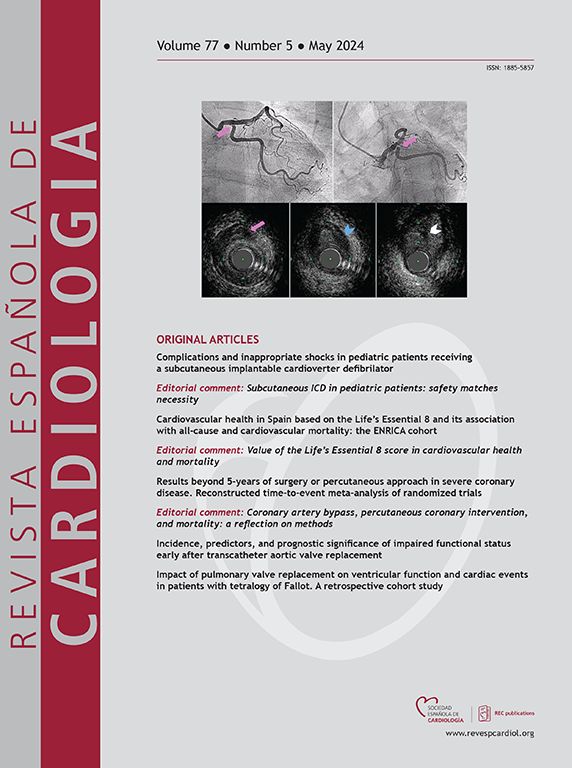经腹瓣膜经皮替换二尖瓣:伊比利亚经验
IF 5.9
2区 医学
Q2 Medicine
引用次数: 0
摘要
简介和目的导管二尖瓣置换术(TMVR)是一种新兴的二尖瓣(MV)疾病的治疗方案,适用于不适合手术干预或边缘修复的患者。本研究旨在评估该手术的短期和中期结果。方法:我们进行了一项前瞻性登记,包括在伊比利亚半岛7个中心使用经根尖Tendyne系统接受TMVR的有症状的连续患者的初始经验。基线临床和影像学资料,围手术期信息和随访评估收集于1个月和1年。结果40例患者行TMVR手术,平均年龄78.5岁[76-82],男性47.5%。大多数患者有明显的手术风险、合并症和高级功能分级。除2例严重二尖瓣狭窄外,所有患者均有明显的二尖瓣返流(MR)。既往MV干预和超说明书适应症分别出现在4例(10.0%)和8例(20.0%)患者。30天技术成功率为100%,器械成功率为95.0%,手术成功率为85.0%。随访1个月和1年的全因死亡率分别为2.5%和17.5%。1年生存率分别为93.9%和87.9%,MR降低(≤1)和功能分级改善(NYHA I-II)。结论经TMVR治疗后1年的随访,患者病情得到持久缓解,功能明显增强。尽管在这一高危人群中1年死亡率仍然相对较高,但该手术显示出令人满意的早期安全性。本文章由计算机程序翻译,如有差异,请以英文原文为准。
Vía transapical para reemplazo percutáneo de válvula mitral por valvulopatía: una experiencia ibérica
Introduction and objectives
Transcatheter mitral valve replacement (TMVR) is an emerging treatment alternative for mitral valve (MV) disease in patients who were ineligible for surgical intervention or edge-to-edge repair. This study aimed to assess the short- and mid-term outcomes of this procedure.
Methods
We conducted a prospective registry to include the initial experience with symptomatic, consecutive patients who underwent TMVR using the transapical Tendyne system at 7 centers in the Iberian Peninsula. Baseline clinical and imaging data, periprocedural information, and follow-up assessments were collected at 1 month and 1 year.
Results
A total of 40 patients (mean age 78.5 years [76-82], 47,5% males) underwent TMVR. The majority had significant surgical risk, comorbidities, and advanced functional class. All patients had significant mitral regurgitation (MR), except for 2 with severe stenosis. Previous MV intervention and off-label indication for the procedure were present in 4 (10.0%) and 8 (20.0%) patients, respectively. Technical success was recorded in 100%, device success in 95.0%, and procedural success in 85.0% at 30-day. All-cause mortality was 2.5% and 17.5% at the 1-month and 1-year follow-up, respectively. MR reduction (≤ 1) and functional class improvement (NYHA I-II) were observed at 1 year in 93.9% and 87.9% of survivors, respectively.
Conclusions
Treatment with TMVR produced enduring resolution of MV disease and notable functional enhancement at 1 year of follow-up. The procedure demonstrated a satisfactory early safety profile, although 1-year mortality remained relatively high in this high-risk population.
求助全文
通过发布文献求助,成功后即可免费获取论文全文。
去求助
来源期刊

Revista espanola de cardiologia
医学-心血管系统
CiteScore
4.20
自引率
13.60%
发文量
257
审稿时长
28 days
期刊介绍:
Revista Española de Cardiología, Revista bilingüe científica internacional, dedicada a las enfermedades cardiovasculares, es la publicación oficial de la Sociedad Española de Cardiología.
 求助内容:
求助内容: 应助结果提醒方式:
应助结果提醒方式:


